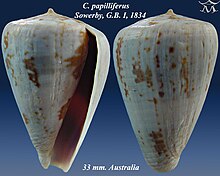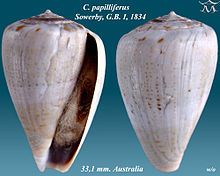Species of sea snail
| Conus papilliferus
|

|
| Apertural and abapertural views of shell of Conus papilliferus Sowerby, G.B. I, 1834
|

|
Scientific classification 
|
| Domain:
|
Eukaryota
|
| Kingdom:
|
Animalia
|
| Phylum:
|
Mollusca
|
| Class:
|
Gastropoda
|
| Subclass:
|
Caenogastropoda
|
| Order:
|
Neogastropoda
|
| Superfamily:
|
Conoidea
|
| Family:
|
Conidae
|
| Genus:
|
Conus
|
| Species:
|
C. papilliferus
|
| Binomial name
|
Conus papilliferus
G. B. Sowerby I, 1834
|
| Synonyms[1]
|
- Conus (Floraconus) papilliferus G. B. Sowerby I, 1834 · accepted, alternate representation
- Conus comptus A. Adams, 1855 (Invalid: junior homonym of Conus comptus Gould, 1853)
- Conus jukesii Reeve, 1848
- Conus rossiteri Brazier, 1870
- Floraconus papilliferus (G. B. Sowerby I, 1834)
|
Conus papilliferus, common name the papilla cone, is a species of sea snail, a marine gastropod mollusk in the family Conidae, the cone snails and their allies.[1]
Like all species within the genus Conus, these snails are predatory and venomous. They are capable of "stinging" humans, therefore live ones should be handled carefully or not at all.
Description
The shell of Conus papilliferus is relatively small to medium-sized, with adult shells varying in size between 20 mm and 50 mm.[2] The shell is characterized by its conical shape and intricate patterns. The coloration of the shell can vary, but it typically features a combination of light and dark hues that provide camouflage against the seabed.[3] The surface of the shell is adorned with fine spiral ridges and grooves, which add to its intricate appearance. The aperture is narrow, and the outer lip is thin and slightly flared.[4]
The shell's structure is adapted to its marine habitat, providing protection against predators and harsh environmental conditions. The species exhibits a high degree of morphological variation, which is common among marine gastropods and is influenced by environmental factors such as water temperature, salinity, and substrate type.
![[icon]](//upload.wikimedia.org/wikipedia/commons/thumb/1/1c/Wiki_letter_w_cropped.svg/20px-Wiki_letter_w_cropped.svg.png) | This section needs expansion. You can help by adding to it. (November 2015) |
Distribution
This marine species is endemic to Australia and occurs in the shallow subtidal zone off New South Wales, Queensland and Victoria.
References
- Sowerby, G.B. (1st) 1834. Conus. pls 54–57 in Sowerby, G.B. (2nd) (ed). The Conchological Illustrations or coloured figures of all the hitherto unfigured recent shells. London : G.B. Sowerby (2nd).
- Reeve, L.A. 1848. Monograph of the genus Conus. supp. pls 1–3 in Reeve, L.A. (ed). Conchologia Iconica. London : L. Reeve & Co. Vol. 1.
- Wilson, B.R. & Gillett, K. 1971. Australian Shells: illustrating and describing 600 species of marine gastropods found in Australian waters. Sydney : Reed Books 168 pp.
- Wilson, B. 1994. Australian Marine Shells. Prosobranch Gastropods. Kallaroo, WA : Odyssey Publishing Vol. 2 370 pp.
- Röckel, D., Korn, W. & Kohn, A.J. 1995. Manual of the Living Conidae. Volume 1: Indo-Pacific Region. Wiesbaden : Hemmen 517 pp.
- Petit, R. E. (2009). George Brettingham Sowerby, I, II & III: their conchological publications and molluscan taxa. Zootaxa. 2189: 1–218
- Puillandre N., Duda T.F., Meyer C., Olivera B.M. & Bouchet P. (2015). One, four or 100 genera? A new classification of the cone snails. Journal of Molluscan Studies. 81: 1–23
External links

